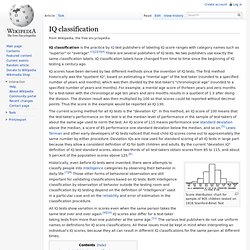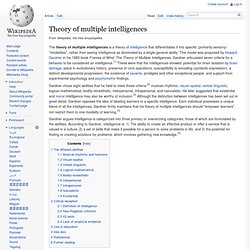

Howard Gardner, multiple intelligences and education. Howard Gardner, multiple intelligences and education.

Howard Gardner’s work around multiple intelligences has had a profound impact on thinking and practice in education – especially in the United States. Here we explore the theory of multiple intelligences; why it has found a ready audience amongst educationalists; and some of the issues around its conceptualization and realization. Contents: introduction · howard gardner – a life · howard gardner on multiple intelligences · the appeal of multiple intelligences · are there additional intelligences? · howard gardner’s multiple intelligences – some issues and problems · conclusion · further reading and references · how to cite this article I want my children to understand the world, but not just because the world is fascinating and the human mind is curious. Howard Earl Gardner’s (1943- ) work has been marked by a desire not to just describe the world but to help to create the conditions to change it.
7 Wrong Answers About Standardized Tests. Does a friend say the ACT is way easier than the SAT?

Does your aunt tell you that no one can get into an Ivy without taking five subject tests? What's a stressed-out high schooler to do? Chill. As a test-prep geek and founder of the educational consulting firm PrepMatters, I'm here to debunk the common myths of standardized testing. Myth 1: Standardized tests are IQ tests. Knowing the meanings of laconic, loquacious, or lugubrious does not prove you are smart. The first step in test preparation, therefore, should be to shift how you view these tests and your potential for success on them.
[Get tips from the U.S. Myth 2: Taking both tests will double your chances of doing well. Yes, these tests matter. If you are remarkably better at one test, it should become evident pretty quickly after some practice. Myth 3: The ACT is an easier test than the SAT. The ACT is a different test, not better or easier. The Dangerous Consequences of High-Stakes Standardized Testing. Tests are called "high-stakes" when they used to make major decisions about a student, such as high school graduation or grade promotion.

To be high stakes, a test has to be very important in the decision process or be able to override other information (for example, a student does not graduate if s/he does not pass the test regardless of how well s/he did in school). Currently, 17 states require students to pass a test to graduate, and 7 more are planning such tests. Tests are called "standardized" when all students answer the same questions under similar conditions and their responses are scored in the same way. The Pros of Standardized Testing. Accountability has been a buzz word for the past few years since No Child Left Behind, a bill that aims to reform education by improving academic standards, with goals such as: holding states more accountable for results, creating greater flexibility at the state and local levels, expanding options and choice for parents, emphasizing teacher quality and effective teaching methods, and confirming states' progress.

Accountability at the school level will encourage positive changes such as the revision of district curriculum and testing programs so that they become consistent with state curricula. It also leads districts and schools to use their resources more effectively, for example by hiring more qualified teachers and providing after-school tutoring sessions. Results from standardized tests can help reallocate funds to schools who performed well and deserve a reward, and to those schools most in need. IQ reference chart. IQ classification is the practice by IQ test publishers of labeling IQ score ranges with category names such as "superior" or "average".[1][2][3][4] There are several publishers of IQ tests.

No two publishers use exactly the same classification labels. IQ classification labels have changed from time to time since the beginning of IQ testing a century ago. IQ scores have been derived by two different methods since the invention of IQ tests. The Brain Performance Test. Compare your unique brain against others and reveal your potential How high is your Brain Power Score?

See how your brain's abilities compare in your age group. Mastermind? Innovator? Standardized Tests - ProCon.org. Theory of multiple intelligences. The theory of multiple intelligences is a theory of intelligence that differentiates it into specific (primarily sensory) "modalities", rather than seeing intelligence as dominated by a single general ability.

This model was proposed by Howard Gardner in his 1983 book Frames of Mind: The Theory of Multiple Intelligences. Gardner articulated seven criteria for a behavior to be considered an intelligence.[1] These were that the intelligences showed: potential for brain isolation by brain damage, place in evolutionary history, presence of core operations, susceptibility to encoding (symbolic expression), a distinct developmental progression, the existence of savants, prodigies and other exceptional people, and support from experimental psychology and psychometric findings.
Gardner argues intelligence is categorized into three primary or overarching categories, those of which are formulated by the abilities. The different abilities[edit] Musical–rhythmic and harmonic[edit] Interpersonal[edit]